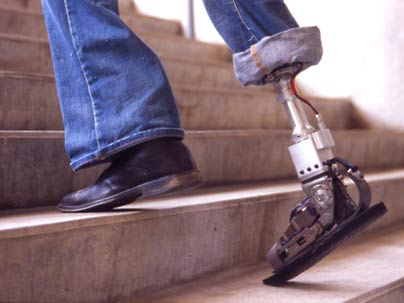iWalk, a Cambridge, MA, startup backed by Nicholas Negroponte, founder of the One Laptop per Child organization and one of the original investors in Wired magazine, has unveiled what it says is the world’s first robotic ankle.
The device, called PowerFoot One, was created by a team of Massachusetts Institute of Technology researchers, led by a professor who co-founded iWalk and now serves as its chief scientific officer.
PowerFoot One uses microprocessors and environmental sensors to propel users forward and create a sensation of walking normally. Control algorithms generate human-like force while walking on level ground or climbing slopes and stairs, providing amputees with near normal gait and lower energy expenditure compared with traditional prosthetics.
“This design releases three times the power of a conventional prosthesis to propel you forward and, for the first time, provides amputees with a truly human-like gait,” said iWalk co-founder and chief scientific officer Hugh Herr, in an article issued by MIT’s press office.
According to iWalk’s Web site, the device will be available next summer.
An initial target will be amputees returning from Iraq and Afghanistan. PowerFoot One was introduced yesterday at the Veterans Affairs Medical Center in Providence, RI, and demonstrated by a soldier who lost his leg below the knee in battle in Iraq. According to Reuters, the soldier “showed almost no sign of a limp” during the demonstration. And he later told the news organization, “Once you get used to it, it feels like you have your leg back.”
Joel Kupersmith, Veteran Affairs’ chief research and development officer, told MIT’s reporters after the unveiling that PowerFoot One offers significant advantages over currently available prosthetics. “Up to now, prosthetic devices have not been able to duplicate the complex functions of our feet and ankles as we walk and run,” said Kupersmith. “The ingenious computerized design of this new prosthesis changes all of this, as it constantly ‘thinks’ and responds, allowing the person to walk or run in a more natural and comfortable way.”
iWalk isn’t the only company looking to create a more natural mechanism for below-the-knee amputees. Ossur, an Icelandic company, is using artificial intelligence to develop a prosthetic foot that reacts in real-time to users’ movements. The VA and the U.S. Department of Defense are also backing Ossur’s Proprio Foot, which was the winner of a 2007 Medical Design Excellence Award and featured this month in Business Week‘s Cutting-Edge Designers issue.
Ossur’s device has been out since September 2006 and has already been used on multiple soliders returning from Iraq and Afghanistan. The company has also applied its bionic technology — the kind used to develop the Proprio Foot — to two knee prosthetics, the Rheo Knee and Power Knee. The Rheo Knee was actually developed by iWalk’s Herr, himself a double amputee, and has been hailed by such media outlets as Fortune, Time, Business 2.0 and Popular Mechanics.
